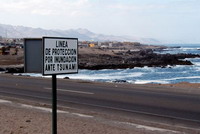Northern Chile under attack of quake
A major earthquake descended upon northern Chile on Wednesday. Authorities reported at least 20 injured, but no deaths.

The quake, which struck at 12:40 local time (10:40 EST; 1540 GMT), was felt strongly in the Chilean capital, 1,260 kilometers (780 miles) to the south, as well as in neighboring Peru and Bolivia.
The U.S. Geological Survey calculated the magnitude at 7.7, a major quake. It was followed by several aftershocks, including two larger than magnitude 5.
Some houses were damaged in the port city of Tocopilla, according to Deputy Interior Minister Felipe Harboe, "and some people were injured, apparently none seriously." The government's Emergency Bureau said at least 20 people also were injured in the small town of Maria Elena and Mayor Eduardo Ahumada said some houses were damaged.
Presidential spokesman Ricardo Lagos Weber said power was cut in several cities in northern Chile Presidential spokesman Ricardo Lagos Weber said power was cut in several cities.
Television showed cars crushed by the collapse of a hotel entryway in Antofagasta, 170 kilometers (105 miles) south of the epicenter. A reporter for Radio Cooperativa said she saw cracks in the tarmac at the airport in Antofagasta.
"It was horribly strong. It was very long and there was a lot of underground noise," said Andrea Riveros, spokeswoman for the Park Hotel in Calama, 100 kilometers (60 miles) from the quake's center and site of the large Chuquicamata copper mine, owned by Codelco, which reported power outages but no major damage.
At the nearby Agua del Desierto Hotel, administrator Paola Barria said she felt like she was riding on "a floating island." She reported downed power lines, cracked windows and fallen pieces of houses near the hotel.
"I was very frightened. It was very strong," she said. "I've never felt one that strong."
Schools, hospitals and other buildings were evacuated in several cities. Television showed some patients holding their serum bags as they were wheeled from the hospital in Copiapo, 800 kilometers (500 miles) north Santiago.
The U.S. Pacific Tsunami Warning Center issued, then cancelled a tsunami warning for Chile and Peru. It said the quake generated only a 0.7-meter (2-foot) wave.
In the Bolivian capital of La Paz, 385 miles (620 kilometers) northeast of the epicenter, some high-rise buildings were evacuated, but there was no apparent damage and people soon returned to their offices.
John Bellini, a USGS geophysicist at the National Earthquake Information Center in Golden, Colorado, said the earthquake's epicenter was relatively shallow, 60 kilometers (38 miles) down.
He said it could have caused greater damage to a more populated and developed area.
"If this magnitude earthquake at the same depth had happened down near Santiago, there would be a lot more damage and casualties," Bellini said.
The quake occurred in "one of the most seismically active regions in the world," Bellini said, where the Nazca tectonic plate is shoving itself beneath the South American plate.
A 1939 quake in Chile killed 28,000 people and in 1960, a magnitude-9.5 quake - the largest recorded in the 20th century - killed 5,700 people.
On June 13, 2005, a magnitude-7.8 quake near Tarapaca in northern Chile killed 11 people and left thousands homeless.
Subscribe to Pravda.Ru Telegram channel, Facebook, RSS!


